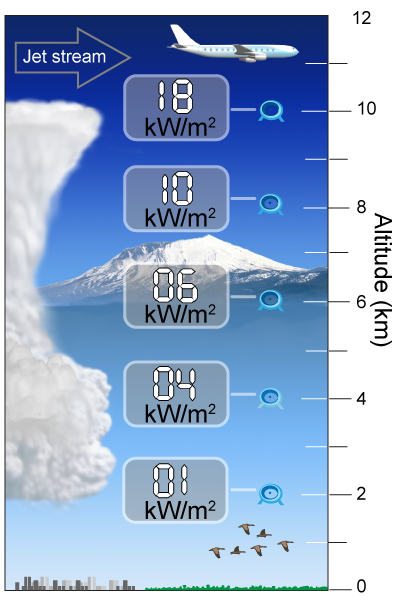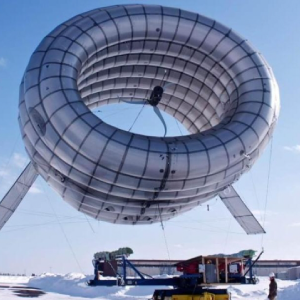|
At very low altitudes, wind loses energy from friction with the ground. Reach up a few hundred meters, however, and the wind blows more vigorously and more often. In the past few years, this untapped resource has spawned a new industry: high-altitude wind power. In this fledgling industry, high-tech kites, blimps, and gliders are taking the place of towering windmills. 
|
 The ultimate goal of wind power might be to tap into the jet stream—the river of air that circles the globe at temperate latitudes, powered not only by solar heating but by the Earth’s rotation. Some 10 km above ground, this atmospheric current can shorten (or lengthen!) the travel times of cross-continental passenger jets by an hour or more. Above several cities, the jet stream could provide at least 10 kW to a turbine with a cross-sectional area of just one square meter—a windmill you probably could rest on your bed. A power output of 10 kW can provide for the domestic needs of five to ten small households. Tokyo, Seoul, and New York are among the Northern Hemisphere cities blessed with strong, fairly reliable winds at altitudes of 10 km.
The ultimate goal of wind power might be to tap into the jet stream—the river of air that circles the globe at temperate latitudes, powered not only by solar heating but by the Earth’s rotation. Some 10 km above ground, this atmospheric current can shorten (or lengthen!) the travel times of cross-continental passenger jets by an hour or more. Above several cities, the jet stream could provide at least 10 kW to a turbine with a cross-sectional area of just one square meter—a windmill you probably could rest on your bed. A power output of 10 kW can provide for the domestic needs of five to ten small households. Tokyo, Seoul, and New York are among the Northern Hemisphere cities blessed with strong, fairly reliable winds at altitudes of 10 km. 
|
 The jet stream may be wind power’s ultimate goal, but in the meantime wind power can make meaningful gains by climbing just a few hundred meters. Humans have taken their first practical steps toward power generation at these more modest altitudes. Altaeros Energies, a Massachusetts-based company, has recently launched helium-filled vessels that carry small but conventional wind turbines. In tests, this company’s engineers deployed a 10 m prototype over a frigid winter landscape in Maine. The floating windmill ascended to an altitude of 100 m and generated electric current, which was carried to the ground by cables. Altaeros plans to make airborne turbines that can operate 300 m up, where winds can typically provide substantially more power than they do for fixed-height generators.
The jet stream may be wind power’s ultimate goal, but in the meantime wind power can make meaningful gains by climbing just a few hundred meters. Humans have taken their first practical steps toward power generation at these more modest altitudes. Altaeros Energies, a Massachusetts-based company, has recently launched helium-filled vessels that carry small but conventional wind turbines. In tests, this company’s engineers deployed a 10 m prototype over a frigid winter landscape in Maine. The floating windmill ascended to an altitude of 100 m and generated electric current, which was carried to the ground by cables. Altaeros plans to make airborne turbines that can operate 300 m up, where winds can typically provide substantially more power than they do for fixed-height generators. 
|
Suppose that you live in a research station, where you and several colleagues are investigating wildlife and climate change. Assume that your station has sole use of one of the floating windmills shown in the above figure. Assume, too, that the windmill has an effective area of one square meter (1 m2). What altitude would it need to reach to reliably power six 100 W lamps, two 200 W refrigerators, four 100 W computers, a 2,000 W well pump, a 2,400 W water heater, and 200 W of miscellaneous household needs?
 |
Since the device has a wind-catching area of 1 m2, we can directly use the numbers on the illustrated power meters to tell us how many kilowatts would be provided. So let’s add up the station’s power needs.
The lamps consume a total of 6 × 100 W = 600 W of electrical power; the refrigerators, 2 × 200 W = 400 W; and the computers, 4 × 100 watts = 400 W. That adds up to a subtotal of 600 W + 400 W + 400 W = 1,400 W.
Meanwhile, we also have to include the well pump (2,000 W), the water heater (2,400 W), and miscellaneous needs (200 W). Adding those three quantities to the previous subtotal yields a grand total of 6,000 W, or 6 kW.
The illustration shows that one windmill with a 1 m2 area will generate 6 kW at an altitude of 6 km. 
|
| |
|

